Excel databases: Creating relational tables - turnerpeetruse2001
Excel possesses formidable database powers. Creating a relational database starts with a Overcome table that links it to subordinates, called (awkwardly) Slave, Child, operating theatre Detail tables.
Before we dive in, we've provided you with a sample workbook you can consumption to follow on with our how-to and rehearse each step. Just fall into place the arrow or link below to start the download.
This is a workbook with eight-fold spreadsheets whose content can personify wont to practice Excel tasks in relative databases, reports, and pivot tables. JD Sartain
How relational databases workplace
Excel's organisational structure lends itself well to how databases work. A database is a collection of connected items (spreadsheet) that, when related, creates a single memorialize (rowing) inside a group of multiple records (table).
One spreadsheet, unaccompanied, is a database, but not a relative one. The relational database is a combination of the Master spreadsheet table and all of its Slave tables or spreadsheets.
For example, your driver's license is a single record in a flat-file database that resides on a estimator at the Department of Motive Vehicles (DMV). Your permission contains your name, sexuality, height, weight, eyes and hair color, address, engagement of parturition, license takings and expiration date, license class.
Because information technology's achievable to have duplex people with the Sami name, address, gender, and verbal description (like a father and son), driver's licenses every last have license numbers. This unique number is called a Cay Field, which is used to connect a flat-file database to other associated databases (called relative databases).
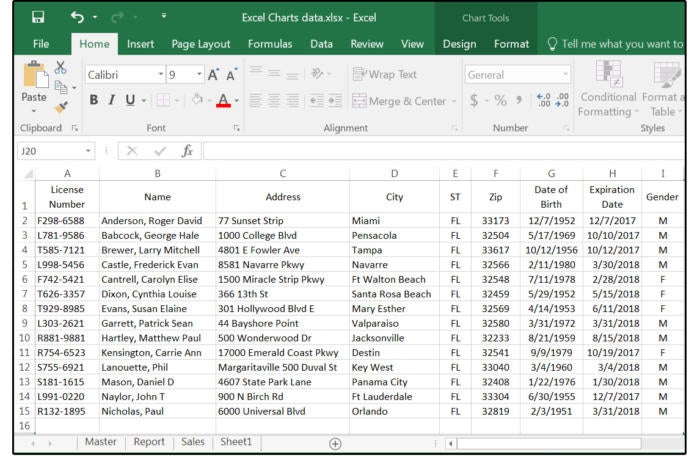 JD Sartain / PC Cosmos
JD Sartain / PC Cosmos A basic flat-file spreadsheet database
This foundational Master database (in this example) contains all the information that's on your driver's certify. Extraordinary or to a greater extent related databases, called Slave, Child, or Detail databases, contain additive information that's related to the individual drivers (identified by the unique fundamental field License Number). E.g., unity Slave database power contain all of the individual's dynamical violations, while another might stop all the previous addresses of the individual drivers. This type of relational database is called a One-to-Many relationship, which substance each driver fire have multiple violations or multiple addresses, but the violations and/Oregon addresses databases cannot have multiple drivers.
Else types of relationships include One-to-One and Umpteen-to-Many. In a Sales database where customers purchase products, some customers might meet specialised discount rates (much as in large quantities, retail, task exempt, etc.), which would require a Discount Rate database. That would be a matched kinship with the Customer database. When a customer buns purchase many products and the same ware can be purchased by many customers, you have a many-to-umpteen relationship.
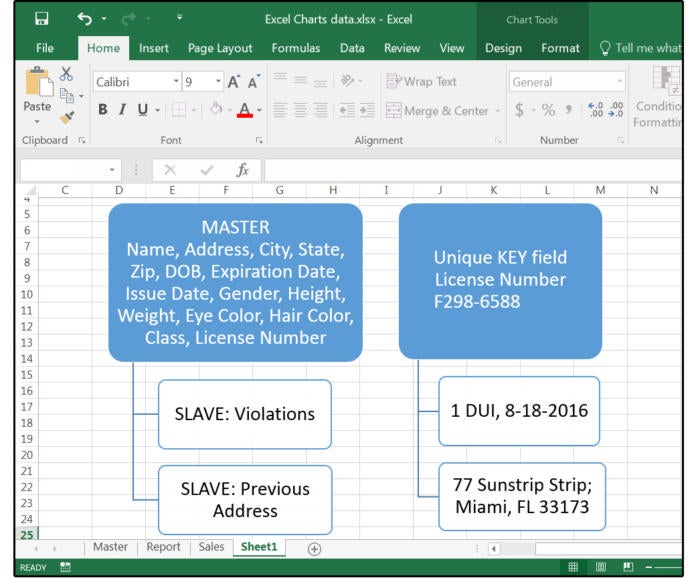 JD Sartain / PC Human race
JD Sartain / PC Human race Relational Database Master and Slaves
Who needs a relational database
In that respect are more reasons to produce relative databases. The most obvious is so you don't repeat the same data on every spreadsheet in your workbook. For deterrent example, it's redundant, time-consuming, and resource-intensive to retype all the driver's names and birth dates from the Master database to the multiple Slave databases. And flat if you transcript the information from one to the opposite, IT still uses unnecessary disk space and memory, which slows everything down. Also, the make and birthdate are not actually unique. For example, there are likely hundreds of Gob Taylors and John Smiths, and some of these could well have the same birthdate. But if you just use the Certify Number, you tin't identify the drivers, so you'atomic number 75 forced (to be safe) to use altogether deuce-ac Fields (at least).
The most essential reason for relational databases is to create queries and filters that can extract specific selective information and print reports. Say your boss wants a report that shows everyone in Santa Rosa County, Florida with traffic fines in excess of $300; or how many drivers in Pensacola have license renewal dates in December? Without the relational database capacitance, you would get to hack and spread this information together from threesome or more than spreadsheets onto a fourth spreadsheet, then go for—when you're entirely finished—your boss doesn't announce, "I said Sarasota County, non Santa Rosa County."
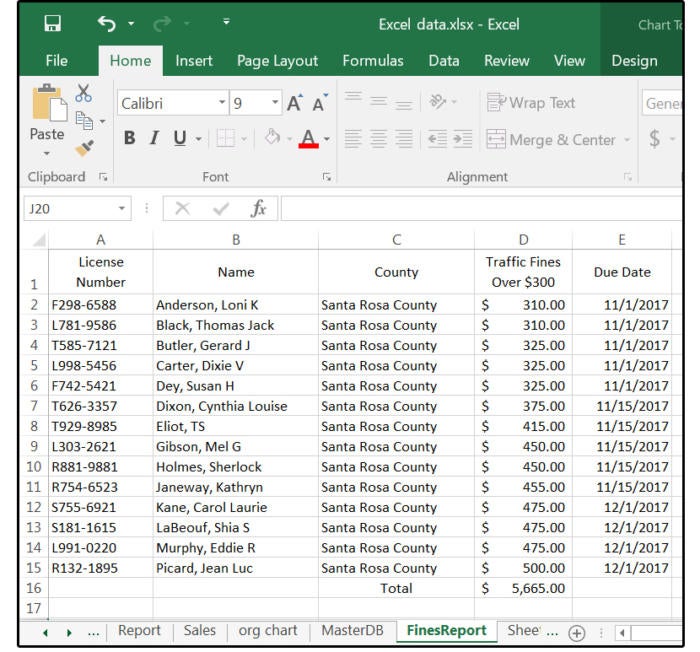 JD Sartain / PC Globe
JD Sartain / PC Globe Relative database reports–dealings fines
Create a relational database
Let's create a relational database with several abstracted tables or spreadsheets.
Creating the Victor Table
1. Use the aforesaid fields shown in the first screenshot above ("A basic flat-file spreadsheet database"), and then make out 12-15 records with your own information (or use ours). Those fields are: License Number, Name, Computer address, City, DoS, Zip, Particular date of Birth, Expiration Appointment, and Sex.
2. When finished, highlight the entire table including the headers; that is A1 through I15 (A1:I15). Commend that CTRL+A highlights the whole remit in one stroke, as long as your cursor is positioned somewhere/anywhere at bottom the remit range.
3. Select the tab and push: Insert > Table
4. If the range is highlighted (which it should be), the range dea appears in the field called: Where is the data for your tabular array in the Create Tabular array dialogue box. Mark off the box that says: My Table Has Headers, then click Very well.
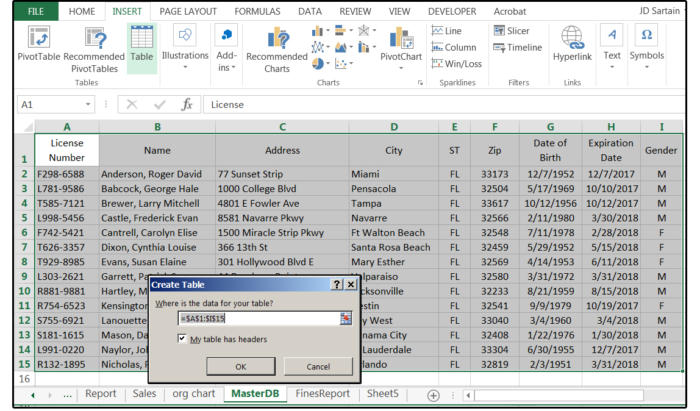 JD Sartain / PC World
JD Sartain / PC World Create/Insert the Master Hold over
5. Equally shortly as that dialogue window closes, BE SURE to mention your table in the Table Name field box (top left niche) in the Properties group (on the current screen). Type MASTER, and then iron out the Getting even key.
6. Notice the postpone now shows down arrows beside each field constitute. Click one of the toss off arrows (e.g., Metropolis) and notice the dialog menu box that appears. This box contains Sort options that admit filters, which allow you to exhibit specific information supported on the elect strain. For example, if you uncheck the Select All field of operations box, and so check only the field boxes that say Miami and Destin, Excel filters Verboten all cities EXCEPT Miami and Destin.
NOTE: Father't panic when all the remaining records disappear. They are not gone, just hidden. To view them again, click the down arrow beside the field Metropolis, then click the Altogether button, and they're visible again directly.
TIP:Tick the School tex Filtrates option connected the Filters dropdown bill of fare to select filtering options from the popup inclination (as opposed to just matching fields from the Checkbox Inclination). Options include Equals, Does Non Same, Begins With, Ends With, Contains, Does Not Contain, Custom Filter.
7. Commend to change the tab (that says Sheet1) at the nether of the spreadsheet to say Master. Double-click the spreadsheet tab to interchange the bring up quickly.
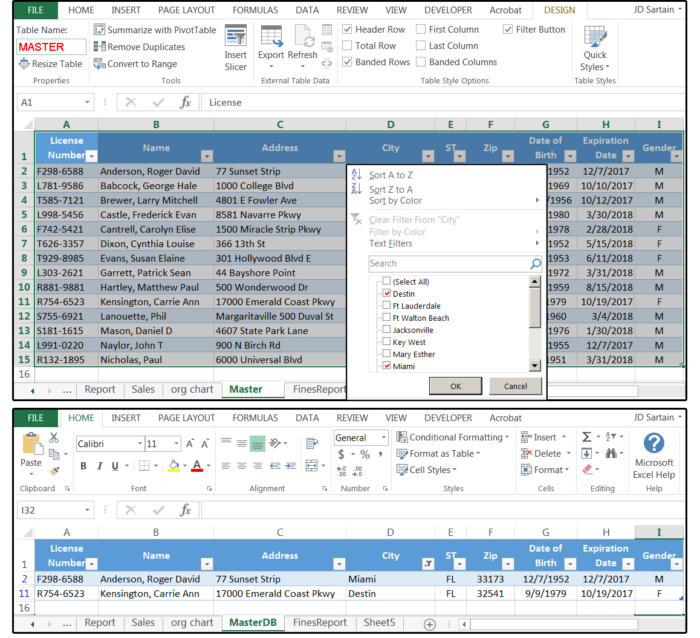 JD Sartain / PC Macrocosm
JD Sartain / PC Macrocosm Use filters to selection specific information from your spreadsheet table
Slave Tables
1. Adjacent, create the Slave Tables. Press the + (plus sign) on the Piloting bar to add two additional spreadsheets. Name single of these Violations and the other Addresses.
2. Copy pillar A (Permit Numbers racket) to column A in both of the past spreadsheets. Aline the column widths to 11.
NOTE: Commend, the Buckle down table therein lesson is a one-to-many, which substance there are multiple records per driver, so the Key field (License Add up) privy—and leave—be repeated many times. We are copying it to the Slave tables so you don't have to re-enter the data. For each multiple entry, just recopy the Certify Number before you enter the data in the rest of each record.
3. Use the same fields shown in the following screenshot "Relational database: Violations Slave Table" below, and then fill in your ain data (or role ours). Those fields are: License Number (in newspaper column A, course), Violation Eccentric, Violation Fee, Violation Date, Departure Date, Fee Paid Date
4. Enter around 30 records with continual License Numbers. For example: License number F298-6588 is repeated threefold. This means Roger Philip Warren Anderson (the driver with this license number) has three number one wood's violations.
5. When finished, highlight the entire table including the headers: A1:H31.
6. Select Insert> Table
7. The cast address appears in the field called:Where is the data for your table in theCreate Hold over dialog box. Check the box that says: My Table Has Headers, then click OK.
8. Arsenic shortly as that dialog window closes, BE SURE to name your table in the Postpone Name champaign box (top left corner) in the Properties aggroup (on the current screen). Type VIOLATIONS, and then press the Return.
9. Click one of the down arrows beside one of the columns/fields. Notice the dialog bill of fare box that appears. Experimentation with the Sorting and Filters to regar different results from this table.
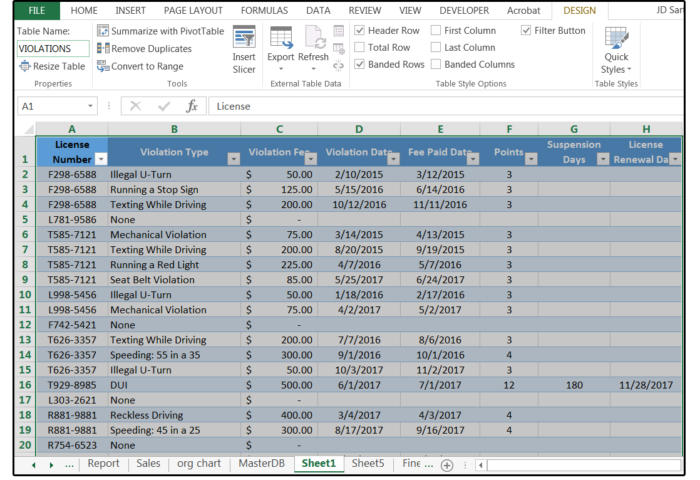 JD Sartain / PC World
JD Sartain / PC World Create the Violations Slave Table spreadsheet
10. For the Addresses Slave defer, return to the Master and copy columns C, D, E, and F (Address, City, State, Zip) to columns B, C, D, and E in the Adresses table (remember, License Telephone number—the unique key field—is already in chromatography column A.)
11. Adjust the column widths to accommodate the data.
12. Enter around 30 records with perennial License Numbers. For example: Registration number F298-6588 is perennial three multiplication. This agency Roger Anderson (the driver with this registration number) has tercet previous addresses.
13. Repeat the instructions from 5 direct 9 in a higher place, this time naming the Table Addresses and defining the range as A1:E31. And that's all there is to that.
 JD Sartain / PC Earthly concern
JD Sartain / PC Earthly concern Create the Addresses Slave Put over spreadsheet
Source: https://www.pcworld.com/article/407518/excel-databases-creating-relational-tables.html
Posted by: turnerpeetruse2001.blogspot.com


0 Response to "Excel databases: Creating relational tables - turnerpeetruse2001"
Post a Comment